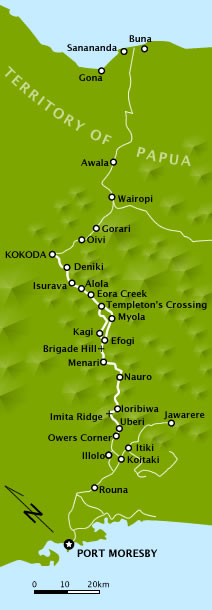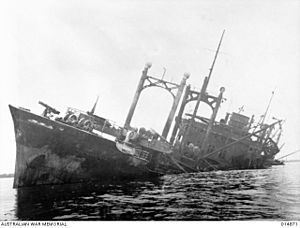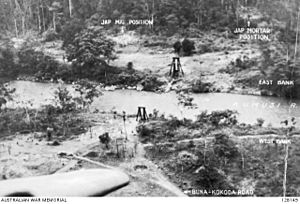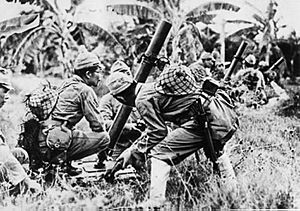Invasion of Buna–Gona facts for kids
Quick facts for kids Invasion of Buna–Gona |
|||||||
|---|---|---|---|---|---|---|---|
| Part of the Pacific Theatre of the Second World War | |||||||
 Aerial reconnaissance photo of Gona shortly after the Japanese landings. (AWM128399) |
|||||||
|
|||||||
| Belligerents | |||||||
| Commanders and leaders | |||||||
| Strength | |||||||
| ~ 100 | 4,057 | ||||||
| Casualties and losses | |||||||
| 6 killed | 1 transport ship sunk 1 transport ship damaged 1 destroyer damaged |
||||||
The invasion of Buna–Gona was a military operation by Imperial Japanese forces. It happened in the Territory of Papua during the Second World War. The Japanese called it Operation RI.
This invasion took place between July 21 and 27, 1942. The Japanese wanted to capture the Buna–Gona area. Their main goal was to launch an attack on Port Moresby by land. They planned to use the Kokoda Track for this attack.
The landings at Buna and Gona marked the start of the important Kokoda Track campaign. Australian land forces did not directly fight the landings. However, a small group of Australian soldiers, called Maroubra Force, fought the Japanese as they moved towards Kokoda. This group included soldiers from the 39th Battalion and the Papuan Infantry Battalion (PIB).
The Australians were first pushed back near Oivi. But they quickly regrouped to defend Kokoda. This led to an initial battle there from July 28–29.
Why the Invasion Happened
In May and June 1942, the Japanese military faced defeats. These happened at the battle of the Coral Sea and battle of Midway. Because of this, they put off their plan to capture Fiji, Samoa, and New Caledonia.
Instead, the Japanese decided to attack Port Moresby. They wanted to cross the Owen Stanley Range by land. Capturing Port Moresby would stop Allied air attacks on Rabaul. It would also give Japan airfields to attack Australia.
By mid-1942, the Allies were making Port Moresby stronger. They were building airfields there and at Milne Bay. General Sir Thomas Blamey ordered Australian troops to Kokoda. Their job was to defend against a land attack on Port Moresby.
On July 14, 1942, soldiers from the 39th Battalion arrived at Kokoda. They joined the PIB, who were already in the area. The Allies were also planning to build an airfield near Buna.
Planning the Attack
The Japanese had failed to capture Port Moresby by sea. This was due to the Battle of the Coral Sea. So, the Japanese 17th Army decided to try a land attack. They believed there was a road between Kokoda and Port Moresby.
Japanese planes flew over the area in June. They reported that a road might exist from Buna to Kokoda. Based on this, the Japanese planned a land attack. This attack would be led by Major General Tomitarō Horii.
An advance group, called the Yokoyama Advance Party, was sent first. Their job was to secure the beach area. They also had to scout towards Kokoda. This group included about 4,000 soldiers and workers. However, not all of them landed with the first ships.
Japanese naval units also landed. They were there to build an airfield near Buna. The rest of the main Japanese force would arrive later in August 1942.
The Japanese Navy's 4th Fleet provided support. This included cruisers and destroyers. The 25th Air Flotilla provided air cover for the ships and landings.
The Landings Begin
On July 21, 1942, a Japanese plane attacked Buna. Soon after, the Japanese ships arrived off Gona. They had avoided Allied planes that were attacking another convoy.
At about 5:30 PM on July 21, the Japanese began landing. They fired some naval guns. The small Australian group at Buna's radio station pulled back. They did not fight the landing troops.
Allied planes attacked the Japanese landings. These attacks continued until nightfall and again the next morning. American bombers attacked the Japanese ships. On July 22, the transport ship Ayatosan Maru was sunk. A destroyer, Uzuki, was slightly damaged.
Allied planes kept bombing the Buna-Gona area daily. The Japanese tried to send more troops. One group of ships got through on July 29. But the ship Kōtoku Maru was hit. Most troops got ashore, but the ship sank on its way back to Rabaul. A third group of ships had to turn back on July 31.
Australian patrols saw the Japanese landings. Captain Sam Templeton was at Buna that morning. He heard about the landings and ordered his troops to move.
On July 23, a patrol from the PIB fought the Japanese near Awala. The Japanese fired heavily, and most of the patrol ran into the jungle. Templeton went back to Kokoda. Major William Thornton Watson took command of the forward troops.
Watson planned another ambush. But his troops pulled back to Wairopi. There, they destroyed a bridge. They harassed the Japanese as they tried to cross the Kumusi River. Then, they withdrew on July 24.
Lieutenant Colonel William T. Owen arrived at Kokoda on July 24. He met Templeton. They went to Gorari, where the Australian troops had gathered. Owen set up an ambush position.
The ambush happened around midday on July 25. Two Japanese soldiers were killed. The Australian force then pulled back to Oivi. More Australian troops arrived at Kokoda on July 26. They were sent forward immediately.
The Japanese attacked Oivi at 3:00 PM. The Australians held them for a while. But they were forced to retreat. Templeton left to warn another group of Australian soldiers. He was never seen again by Australians. Japanese records show he was captured and executed.
Watson took command again. The Australian force was in danger of being surrounded. They broke through towards Deniki. Owen had lost contact with his forward troops. He also withdrew to Deniki on July 27. The next morning, some stragglers reported Kokoda was empty. Owen quickly went back to Kokoda.
What Happened Next
The Japanese forces successfully captured the Buna–Gona area. This gave them a base to support their attack on Port Moresby. A total of 4,057 Japanese soldiers landed. An advance group of 230 soldiers fought the first battles. The Australians had only about 100 soldiers on July 25.
More Japanese troops arrived in the following weeks. The main force of the 144th Infantry Regiment landed on August 18. The 41st Infantry Regiment also landed in August.
The Japanese captured Kokoda in a battle from July 28–29. They pushed the Australians back further in an attack on Deniki in August. Major General Horii joined the advance party at Kokoda. He began to gather his forces for the overland advance.
Australian casualties in the Buna area included six members of ANGAU killed. The first Japanese ground forces were killed on July 25, with two killed and six wounded near Gorari. Another four Japanese were killed and 10 wounded on July 26. Nine Japanese were also killed on the Ayatozan Maru when it was sunk.
Some historians have criticized General MacArthur. They say he failed to plan for occupying Buna. This was despite knowing the Japanese might try to take it. They also say he did not realize the landings were for a land attack on Port Moresby.





